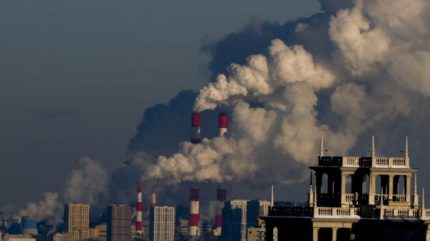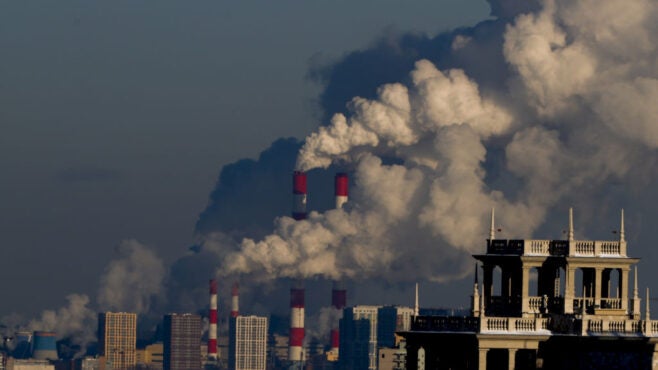

The cost of not dealing with carbon emissions has been spelt out in the IEA’s annual report. (Photo by Sefa Karacan/Anadolu Agency via Getty Images)
The world has made strong but insufficient progress towards decarbonisation over the past year with $4trn of investment needed annually between now and 2030 to reach climate goals, according to the International Energy Agency’s (IEA) latest annual report.
With world leaders preparing to head to Glasgow for COP26 later this month, the IEA’s report highlights that, despite the Covid-induced slump in energy demand in 2020, the global economic recovery has undone last year’s sharp reductions in CO2 emissions. The IEA expects 2021 to see the second-largest year-on-year increase in CO2 emissions in history.
How to reach net zero by 2050
In May, the IEA set out its scenario by which political leaders could reach net-zero carbon emissions by 2050, thereby limiting global temperature increases to 1.5°C above pre-industrial levels while meeting other commitments to poverty reduction and energy security.
The new report notes that “the current direction of travel is a long way from alignment” with this scenario.
If all announced pledges were implemented, the IEA estimates that global temperatures would pass 2.1°C above pre-industrial levels by 2100 and continue rising. This scenario would see demand for oil peak in 2025 and global energy demand plateau from 2030 onwards.
If the road ahead is paved only with good intentions then it will be a bumpy ride indeed. IEA report
If action was limited to those pledges that are being implemented or are under development, however, falling emissions from the power sector would be offset by rapidly increasing emissions from industry, particularly cement and concrete production, and heavy freight – emissions-driven economic development in the Global South.
The report highlights the urgency of decarbonising energy systems in time to meet this expected surge in demand. With growing populations, rising incomes and expanding cities, developing economies are expected to drive the growth in energy demand over the coming decades.
Far more investment is needed to save the planet
While reaching net zero by 2050 remains possible, the report notes that nearly half the emissions reduction required would have to come from technologies that are still only in the demonstration or prototype stage.
Both the development of new technologies and the deployment of existing ones depend on funding. Reaching net zero by 2050, the IEA estimates, would require global annual investments in clean energy to rise to $4trn by 2030.
The report estimates that 70% of the funding gap is concentrated in developing countries, and that 70% of the funding will need to be provided by private sector financial institutions.
Recovery packages have provided some additional funds towards decarbonisation but only one-third of what is necessary. The financial shortfall remains greatest in developing economies, where the cost of capital can be up to seven times higher than in the Global North despite the generally low cost of capital internationally.
The report also warns that “fiscal expansions and inflationary pressures around the world increase the risk of growing debt burdens and higher borrowing costs in the future”.
Balancing decarbonisation and energy security
Under the current direction of travel, emissions from coal are expected to fall by just 10% by 2030. If the world is to reach net zero by 2050, the IEA estimates, emissions from coal will have to fall by 55% before the end of the decade.
Important steps are already being taken to tackle coal. China's recent announcement that it will not build any more coal plants abroad could lead to the cancellation of 190GW of expected new capacity, the report estimates.
If these are replaced with low-emissions generation capacity, the total cumulative carbon emissions prevented by this one policy could be as much as from the EU's commitment to reach net zero by 2050.
Given that coal produced more than one-third of the world's energy in 2020, however, such a rapid reduction has serious implications for jobs and energy security.
Progress towards energy security has already stalled in the past year, with the number of people lacking access to electricity rising by 2% in 2020 – a trend the IEA report attributes to the Covid-19 pandemic. Almost all of the increase was in sub-Saharan Africa.
The IEA identifies the recent surge in energy prices as a symptom of a growing uncertainty in the energy sector and a failure of coordination from governments, resulting in a mismatch between supply and demand.
A collapse in energy prices since 2014 has led to a severe slowdown in oil and gas investment – making this one of the few indicators aligned with the IEA’s target of reaching net-zero emissions by 2050. However, the organisation warns that without increased investment in alternative forms of energy the result could be a "turbulent and volatile period" in the global energy markets.
In order to cushion consumers from the likely oil and gas price shocks, the IEA recommends that governments assist households in reducing their exposure to fossil fuel prices – for example, through improved energy efficiency and increased electrification of household heating.
Greater reliance on electricity generated from renewables will expose households to another kind of price shock, however. Solar, hydro and wind power are vulnerable to severe fluctuations in output.
Low wind speeds in Germany and drought in China are thought to be one reason behind the recent worldwide gas shortages. Nuclear power generators, which can be turned on and off at will, can help to even out such fluctuations and ensure a constant supply of energy. However, running nuclear generators at far below capacity for much of their lifespan can make them prohibitively expensive.
The IEA recommends expanded use of nuclear power along with greater research into large-scale energy storage technology.
Critical minerals may become the new oil
The report also provides a glimpse into a future international energy market, a market in which critical minerals such as lithium, cobalt and copper become the new oil. Oil-rich nations will see their dollar-denominated revenues decline as demand shifts to the minerals necessary for a massive expansion of electric grids, EVs and renewable energy generation.
This will come at a cost to oil-rich nations such as Saudi Arabia and Russia, but could pave the way for a surge in exports from, and investment in, mineral-rich countries such as Afghanistan.
Supply chain disruption and unexpectedly strong demand has caused a sharp rise in commodity prices over the past year, including for critical minerals. The IEA estimates that if current prices are maintained, the cost of investments needed by 2030 in order to limit global warming to 1.5°C would rise by $700bn.
By 2050, the annual market for the manufacture of wind turbines, solar panels, lithium-ion batteries, electrolysers and fuel cells is expected to reach more than $1trn – comparable in size to today's oil market.
The first World Energy Outlook report to foresee a decline in oil demand under every likely scenario, this year’s report offers reasons for optimism. However, the IEA is clear that current pledges will not bring a halt to global warming this century.
"If the road ahead is paved only with good intentions," the report concludes, "then it will be a bumpy ride indeed."
This article is part of a series that GlobalData Media is publishing in the run-up to the next big UN climate conference, COP26, in Glasgow, from 1–12 November 2021. Our focus is on the opportunities and challenges for business of the transition to clean energy and net-zero greenhouse gas emissions. Other articles in this series include:
- Why success at COP26 is vital for business – Investment Monitor
- Is FDI making the climate crisis worse? – Investment Monitor
- Companies need to up their climate game. Can FDI help them? – Investment Monitor
- Business professionals see greenwashing as a major issue, but genuine net-zero action doesn’t have to mean red ink – Investment Monitor
- The success of COP26 rests on it providing an alternative to China’s Belt and Road Initiative – Investment Monitor
- Better late than never? Why COP26 matters, to FDI markets and beyond – Investment Monitor
- Opinion: Africa must not pay the price for the UK’s net-zero ambitions – Investment Monitor
- Grids largely overlooked ahead of COP26 – Energy Monitor
- Carbon markets see promise and peril from COP26 – Energy Monitor
- Overtourism and sustainability in the post-Covid, COP26 era: Should travel be only for the rich? – Railway Technology
- Inside Cervest’s plan to map the world’s climate risk – Verdict
- Shrinking the $9.2tn travel industry’s giant carbon footprint through sustainable tourism – Verdict
- Show us the money: Sustainable finance tech for COP26 to think about – Verdict
- Smart city start-ups rake in the green by boosting sustainability – Verdict
- What drinks brand owners should know about COP26 – sustainability spotlight – Just Drinks
- UK government wants ‘iconic’ British chargepoint design for COP26 – Just Auto
- It’s a fair COP26: Online shopping isn’t sustainable. But these start-ups can help – Verdict
- COP26 – Climate change and the automotive sector (1) – Just Auto
- COP26 panel – How is apparel tackling climate change? – Just Style
- The green revolution: What can you do? – Motor Finance Online
- Hello COP26: These robots can clean the oceans, but they need help – Verdict
- Food giants need to pick up pace on greenhouse gas emissions – Just Food
- How hospitals and the medtech sector are tackling the climate crisis – Medical Device Network
- ISSB: The need for comparable sustainability reporting standards – The Accountant Online
- In the run up to COP26 the ‘S’ in ESG takes off in LatAm – Retail Banker Online


